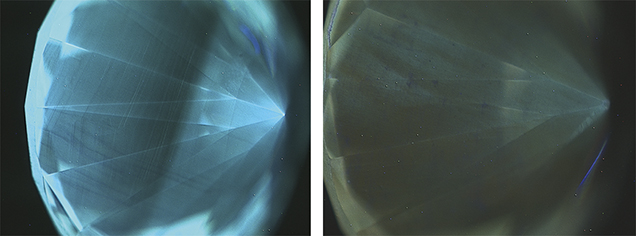Two Fancy Dark Gray CVD Synthetic Diamonds

In addition to their color grade, both showed similar spectra. Neither sample’s UV-visible-NIR spectrum displayed any distinct absorption peaks. The mid-IR spectra identified them as type IIa diamond but did not contain features that confirmed synthetic origin. Their photoluminescence (PL) spectra had nearly identical features, suggesting that they originated from similar manufacturing processes. Both PL spectra featured a large silicon-vacancy doublet at 737 nm, a strong indicator of CVD growth (though natural diamonds will occasionally show a weak silicon peak along with other natural features); this was confirmed by the DiamondView images. The 1.50 ct specimen showed light blue fluorescence and striations commonly observed in CVD synthetics (figure 2, left) (P. Martineau et al., “Identification of synthetic diamond grown using chemical vapor deposition (CVD),” Spring 2004 G&G, pp. 1–25). The 0.80 ct sample offered a more unusual DiamondView image, with yellow fluorescence interspersed with regions of purple mottling. The purple mottling is seen occasionally in CVD synthetics, but usually combined with a background of pink fluorescence (W. Wang et al., “Latest-generation CVD-grown synthetic diamonds from Apollo Diamond Inc.,” Winter 2007 G&G, pp. 294–312) instead of the yellow fluorescence seen here. Some regions of the 0.80 ct synthetic had natural-looking fluorescence features (figure 2, right), but a thorough examination of the DiamondView fluorescence in conjunction with the silicon peak unambiguously identified it as CVD.

Figure 2. Left: In the DiamondView, the 1.50 ct sample showed the familiar color and striations of CVD synthetics. Right: The 0.80 ct specimen displayed a combination of natural-appearing features in some regions (as shown) and CVD-related striations and purple mottling in others. Images by Sally Magaña.
The DiamondView images of both synthetics also demonstrated blue phosphorescence, which is often associated with boron impurities. No known boron-related peaks were detected in the PL or mid-IR spectra, so the boron concentration would be below the level of detection by FTIR spectroscopy. Boron-related peaks seen in natural and treated type IIb diamonds often are not detected in known IIb HPHT- and CVD-grown synthetics. It is unclear whether the low boron concentration was deliberately introduced to improve growth rate and quality (S. Eaton et al., “Diamond growth in the presence of boron and sulfur,” Diamond and Related Materials, Vol. 12, 2003, pp. 1627–1632). Boron-containing diamonds with low color saturation often appear gray, making this element the likely cause of color in both of these CVD synthetic diamonds. 


